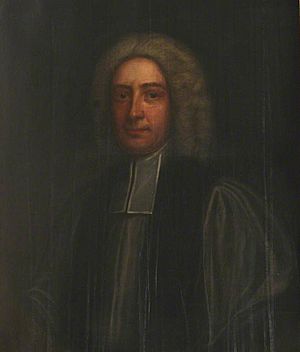Richard Smalbroke facts for kids
Quick facts for kids The Right Reverend Richard Smalbroke |
|
|---|---|
| Bishop of Lichfield and Coventry | |
 |
|
| Diocese | Diocese of Lichfield and Coventry |
| In Office | 1731–1749 |
| Predecessor | Edward Chandler |
| Successor | Frederick Cornwallis |
| Other posts | Bishop of St David's (1724–1731) |
| Personal details | |
| Born | baptized 3 November 1672 |
| Died | 22 December 1749 (aged 77) |
| Buried | Lichfield Cathedral |
| Nationality | British |
| Denomination | Anglican |
| Alma mater | Trinity College, Oxford Magdalen College, Oxford |
Richard Smallbrooke (1672 – 1749) was an important English church leader. He served as a bishop, first in St David's and later in Lichfield and Coventry. Bishops are senior leaders in the Christian church, overseeing many churches and clergy in a specific area called a diocese.
| Top - 0-9 A B C D E F G H I J K L M N O P Q R S T U V W X Y Z |
Early Life and Education
Richard Smallbrooke was born in Birmingham, England, in 1672. His father was Samuel Smallbrooke.
When he was 15, Richard began studying at Trinity College, Oxford, in 1688. He later moved to Magdalen College, Oxford, which is another famous college at Oxford University. He was a very good student, earning his first degree (B.A.) in 1692. He continued his studies, getting his Master's degree (M.A.) in 1695 and his Doctor of Divinity (D.D.) in 1708.
Church Career
Richard Smallbrooke began his career in the church as a chaplain to Thomas Tenison, who was the Archbishop of Canterbury. This was a very important role, as the Archbishop of Canterbury is the leader of the Church of England.
Over the years, Richard held several church positions:
- In 1709, he became the rector of Hadleigh, Suffolk. A rector is a priest in charge of a local church.
- In 1710, he became a canon at Hereford Cathedral. A canon is a member of the clergy who works at a cathedral.
- He also served as a vicar in Lugwardine, Herefordshire, and a rector in Withington, Gloucestershire.
Bishop of St David's
In 1723, Richard Smallbrooke was chosen to become the Bishop of St David's in Wales. He officially became a bishop in 1724. He was a very active bishop. He made sure that certain church teachings, like the Athanasian Creed, were followed. It is said that he even learned the Welsh language so he could lead church services in it.
Bishop of Lichfield and Coventry
In 1731, Bishop Smallbrooke moved to a new role as the Bishop of Lichfield and Coventry. This diocese covered parts of central England. He helped fund new buildings at Magdalen College, where he had studied.
Richard Smallbrooke passed away on December 22, 1749. He was buried in Lichfield Cathedral.
A portrait of Bishop Smallbrooke was painted by T. Murray and later engraved by George Vertue in 1733.
Writings and Beliefs
Bishop Smallbrooke wrote several books and sermons about religious topics. He often discussed important ideas and debated with other thinkers of his time.
For example, he wrote about the importance of baptism and discussed different views on immortality. He also wrote against ideas that challenged traditional Christian beliefs, such as those of William Whiston and Thomas Woolston.
One of his major works was A Vindication of the Miracles of our Blessed Saviour, published between 1729 and 1731. In this work, he defended the miracles performed by Jesus, which were being questioned by some people at the time.
He also spoke out against what he saw as "popery" (a term for the practices of the Catholic Church) and later criticized the early Methodist movement.
Some of his other published works include:
- Reflections on Mr. Whiston's Conduct (1711)
- The Pretended Authority of the Clementine Constitutions confuted (1714)
- Idolatry charged upon Arianism (1720)
- An Enquiry into the Authority of the … Complutensian Edition of the New Testament (1722)
Family Life
Richard Smallbrooke was married to the sister of a doctor named Richard Brooks. They had three sons and four daughters. His son, also named Richard Smalbroke, became the chancellor of the diocese of Lichfield and Coventry and held that position for 64 years.

